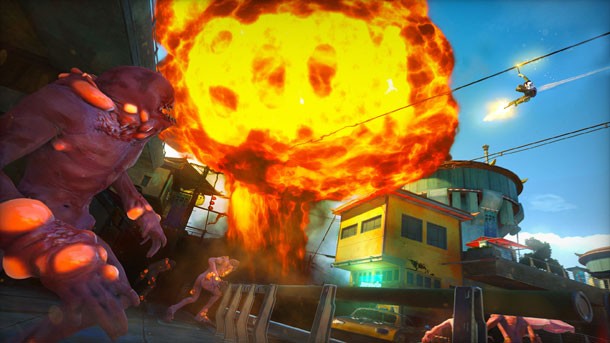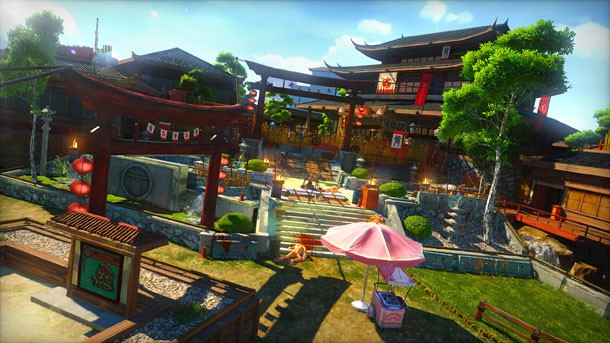Sunset Overdrive

Right now is an exciting time not only for Insomniac Games, but the video game industry as a whole. The new generation of consoles has renewed developers’ enthusiasm towards open-world games. Insomniac Games is venturing into the open-world genre with the colorful, frenetic action of Sunset Overdrive. Insomniac president and CEO Ted Price discusses the studio’s foray into the new space, developing for the Xbox One, and lessons learned from its first multiplatform title Fuse.
Do you that agree the popular trend in triple-A game development is leaning away from shooters and towards the open-world genre?
Yeah, I do. I think part of it is that as developers we can do more. We can create bigger worlds and players want more and more as well. They want more to explore. They want more to experience. They want bigger stories.
Was there a call for open-world games with Insomniac?
I’m sure, I can’t remember specifically, but I’m sure we had discussed opportunities such as open-world games or additional genres within a linear game space. But when Drew [Murray] and Marcus [Smith] [game director and creative director, respectively] pitched it as an open-world game, it clicked for all of us. It was something we knew our technology that we were building could support and it was a way for us to move out of the linear game space that we have been in for so long and just go bigger.
[Drew Murray and Marcus Smith] had a very strong vision for what the game would be and what made it different. We don’t often have new IP pitches around here because we’re generally working on an existing franchise, but I think Marcus and Drew’s presentation was one of the most memorable here at Insomniac just because they put so much passion into it and we could see their personalities coming through in the pitch. And what they were proposing was I think what a lot of us were thinking at the time, which is, "Hey, we need to forge a new path when it comes to shooters and open-world games. We need to do something different." They presented this plan which clicked. Like most of our IPs that get made here at Insomniac, when a great kernel of an idea emerges a lot of people jump onboard and become advocates. This has become a game where the team has really taken ownership of what Sunset Overdrive is and has continued to help it evolve and grow in terms of its personality.

What was important to you in making sure Sunset Overdrive feels like an Insomniac game?
What was important for me was not being a cover-based shooter. Because that has been a trend that has continued for the last decade and certainly we’ve been in that genre as well. We all wanted to do something different. And with an open world that has a strong shooter mechanic we knew we needed to change the rules. During the early parts of the project when we were experimenting with how to break the mold, we experimented heavily with figuring out that magic combination of traversal and combat as a way to move away from the ground-based cover shooters. When it started working we knew we had something special.
Is Insomniac applying any lessons learned from the reception of Fuse for its approach to communicating Sunset Overdrive as a new IP?
With Sunset Overdrive we’re embracing what we love most here at Insomniac, that is the visual stylization, irreverence, taking a unique approach to weapons, taking a unique approach to core mechanics in a genre that most people are familiar with, but in our case is a genre where we see a lot of opportunities to take it in a fresh direction. So what I think we’ve learned over the years in general, not just from Fuse, is just how to express ourselves better and better about what it is that we make. That’s why we’re having so much fun making this game, because it’s a reflection of people at Insomniac expressing themselves 24/7.
At a glance Sunset Overdrive looks like a colorful game with broad appeal to multiple age groups, but it contains strong language and material intended for adults. Do you feel like this might limit the game’s potential market?
Our intent from the very beginning was to create a game for mature audiences. That is shown in the story, the overall themes, some of the dialogue in the game, some of the over-the-top portrayals of characters in the game. Fizzy is a good example of that. We ourselves are adult gamers and we love – I love family-friendly entertainment but at the same time I love games that are made for me. As a shooter fan, and as an adult gamer, I want games where I appreciate the visual aesthetic. I appreciate the humor, but I feel like it’s talking to me on my level.
I think also that it has a lot of elements that will appeal to open-world players and shooter fans of any type, whether you are the type of shooter fan that really has to have the gray, brown serious shooter. We still have a lot of core mechanics that we feel appeal to any fan of games with solid, fun shooting mechanics. We have a deep progression system in the game. There’s a lot to do as the player and a lot to keep you occupied. At the same time, we believe that there’s a compelling story. It doesn’t take itself completely seriously, but there’s a story that follows the development of this character you play and we think will keep players hooked.

Talk to me about the advantages of developing on the Xbox One.
This is a big game. There’s a giant city. There’s a lot to explore. We’re pushing things further visually than on any of our games previously, so you need powerful hardware for that. That’s the obvious answer. And I know a lot of Xbox One owners out there will tell you it’s a powerful machine. There are other aspects of it that I can’t get into right now, but we can talk about them at a later date that would be beneficial for us as a developer.
Fuse marked the first game where Insomniac developed for multiple platforms. What lessons did you learn?
For Fuse we built a brand-new toolset and engine from the ground up. That was very beneficial because we were looking ahead to the next generation and planning for what we knew would be greater efficiencies we need to have when creating large words. We had been working with the same toolset and same engine or some iteration of it for over a decade, and we knew it was time to change things up. So Fuse was beneficial not only in just the technical sense, but in a lot of other ways. We learned a lot of really good lessons on Fuse. That led us to our most colorful and unique game that we’ve made in a long time.
What was it like simultaneously managing the development of console exclusives Ratchet & Clank: Into the Nexus for Sony and Sunset Overdrive for Microsoft?
We’ve had a long and very friendly relationship with Sony over the years. Our relationship with Microsoft has been great as well. As an independent developer that’s one of the great benefits. You can actually work with partners that have very different interests. But because both companies are console manufacturers, we feel familiar with the processes and expectations that both have of their first-party games.
Speaking of Ratchet & Clank, how is the feature-length animated film coming along?
I’m feeling really positive about it. I get a chance to see progress frequently and I’ve been really impressed.
How do you feel about VR tech like Oculus Rift and Sony’s Project Morpheus?
It’s a lot easier for me to talk about where VR is connected not only to this industry, but just as part of our lives as humans. I see tremendous opportunities from a telepresence perspective. In terms of how we can bring people together through VR. I love idea that maybe I can visit my parents in Virgina, virtually. That’s pretty exciting to me. Or go to an event that I could never attend in person, but if I can feel like I’m physically there through Oculus Rift or any other type of VR, that’s amazing. I think that’s ultimately where VR is going to take us.
You recently delivered a DICE talk about removing yourself as a creative bottleneck for the development process. Do you ever miss developing games on the ground level?
I remember fondly a time when 90 percent of my day was spent creating parts of the games we were creating early on. At the same time I get a lot of fulfillment from working with our chief operating officer John Figurito to remove creative roadblocks. I mention that in my speech. Because if I can be surrounded by a team that feels empowered to create anything that comes into their head, that’s amazing. That’s the environment that I dreamed of as a kid. Having the opportunity to dream whatever I can think of. And if I can help provide that for the 200 people at Insomniac, that allows me to leave the office every day feeling like I actually accomplished something.
Check out our hands-on impressions here.

Get the Game Informer Print Edition!
Explore your favorite games in premium print format, delivered to your door.
- 10 issues per year
- Only $4.80 per issue
- Full digital magazine archive access
- Since 1991










